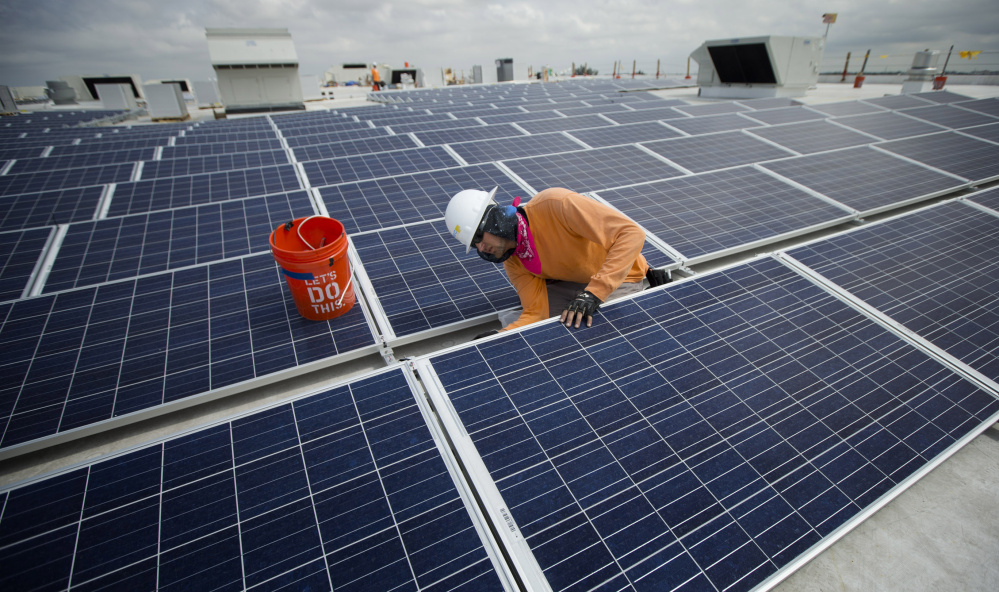Renewable energy projects surpassed all other sources of new electricity added to the global supply last year, says a new report released this week by the International Energy Agency. In 2015, renewables made up more than half of all new installed capacity, with the greatest gains seen in onshore wind and solar.
It’s a development that speaks to a “transformation of global power markets,” according to IEA executive director Fatih Birol. China, for instance – the biggest emitter of greenhouse gases and greatest consumer of coal in the world – has made notable strides in shifting its energy landscape in recent years. While coal is still the nation’s dominant power source, reports suggest its consumption of coal hasn’t grown since 2013, and may even have declined in 2015. In the meantime, the country has become a world leader in the addition of renewables.
That said, renewable energy sources still only account for about 23 percent of the electricity actually produced worldwide, the report notes. The agency predicts that this share will increase to 28 percent by the year 2021, making renewables the fastest-growing source of electricity generation in the world.
The year 2015 was notable for a number of clean energy milestones. According to the new report, both onshore wind and solar photovoltaic installations broke records, with total additions of 63 gigawatts and 49 gigawatts, respectively. The IEA estimates that about half a million solar panels were installed every day around the world last year.
What’s more, the report suggests that the total installed capacity of renewables now exceeds that of coal globally.
China accounted for about 40 percent of total renewable capacity installed in 2015 and about half of all the wind additions.
But the United States may be quickly catching up. For the first time, it’s passed the European Union to become the second largest-growing market in the world. The report predicts that the U.S. will commission 107 gigawatts of new renewable additions – mostly wind and solar – by 2021, a 50 percent increase from 2015. The report attributes the U.S. success to a long-term extension of federal tax credits for renewables, which it suggests has “improved the economics of onshore wind and solar … and has been the key driver in their expansion.”
In general, falling prices have been instrumental in driving the expansion of renewables – and the report suggests that they’ll continue to drop.
It predicts that the costs associated with onshore wind generation will fall by about 15 percent by the year 2021, and utility-scale solar costs will fall by about a quarter. Offshore wind generation may experience the most dramatic declines of all – reports from Europe indicate that prices may fall by as much as 50 percent in the next five years.
The record-breaking progress documented in 2015 marks a “historic milestone that shows communities around the world are recognizing that clean, renewable energy like wind and solar is safer, healthier and increasingly cheaper than fossil fuels,” said Sierra Club executive director Michael Brune in a statement. “The international community has reached a turning point as we hit the accelerator on the transition to a clean energy economy.”
But experts have also cautioned that there are plenty of areas in which renewables could stand to grow. “(E)lectricity alone does not provide the whole picture,” wrote Birol, the IEA executive director, in a foreword to the new report. “Progress in renewable penetration in the heat and transport sectors remains slow, and significantly stronger policy efforts in both sectors will be needed.”
The heat sector, in particular, remains a challenge, the report points out. “Heat accounts for more than half of global final energy consumption and is still primarily supplied by fossil fuels,” it notes, adding that growth over the next five years will likely be slow. Still, by 2021, renewables may contribute 10 percent or more of global heat consumption.
The biggest concern associated with renewable energy, however, is that current trajectories are likely still not enough to meet goals to address climate change. Multiple analyses have already suggested that the pledges made by individual nations under the recent Paris Agreement – most of which hinge on the expansion of renewable energy – still fall short of a goal to keep global average temperatures from increasing by less than 2 degrees.
“Meeting the objective … will require stronger decarbonization rates and accelerated penetration of renewables in all three sectors: power, transport and heat,” the report states.
Send questions/comments to the editors.



Success. Please wait for the page to reload. If the page does not reload within 5 seconds, please refresh the page.
Enter your email and password to access comments.
Hi, to comment on stories you must . This profile is in addition to your subscription and website login.
Already have a commenting profile? .
Invalid username/password.
Please check your email to confirm and complete your registration.
Only subscribers are eligible to post comments. Please subscribe or login first for digital access. Here’s why.
Use the form below to reset your password. When you've submitted your account email, we will send an email with a reset code.